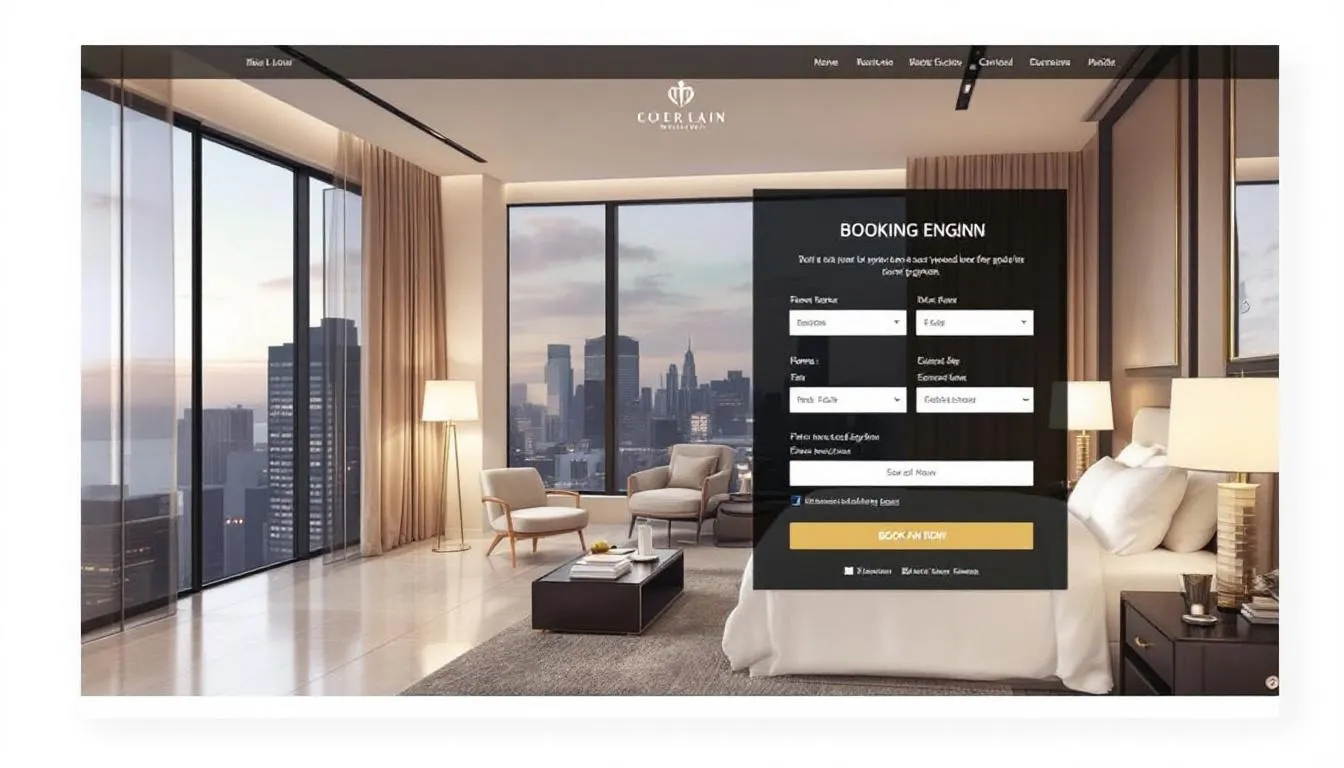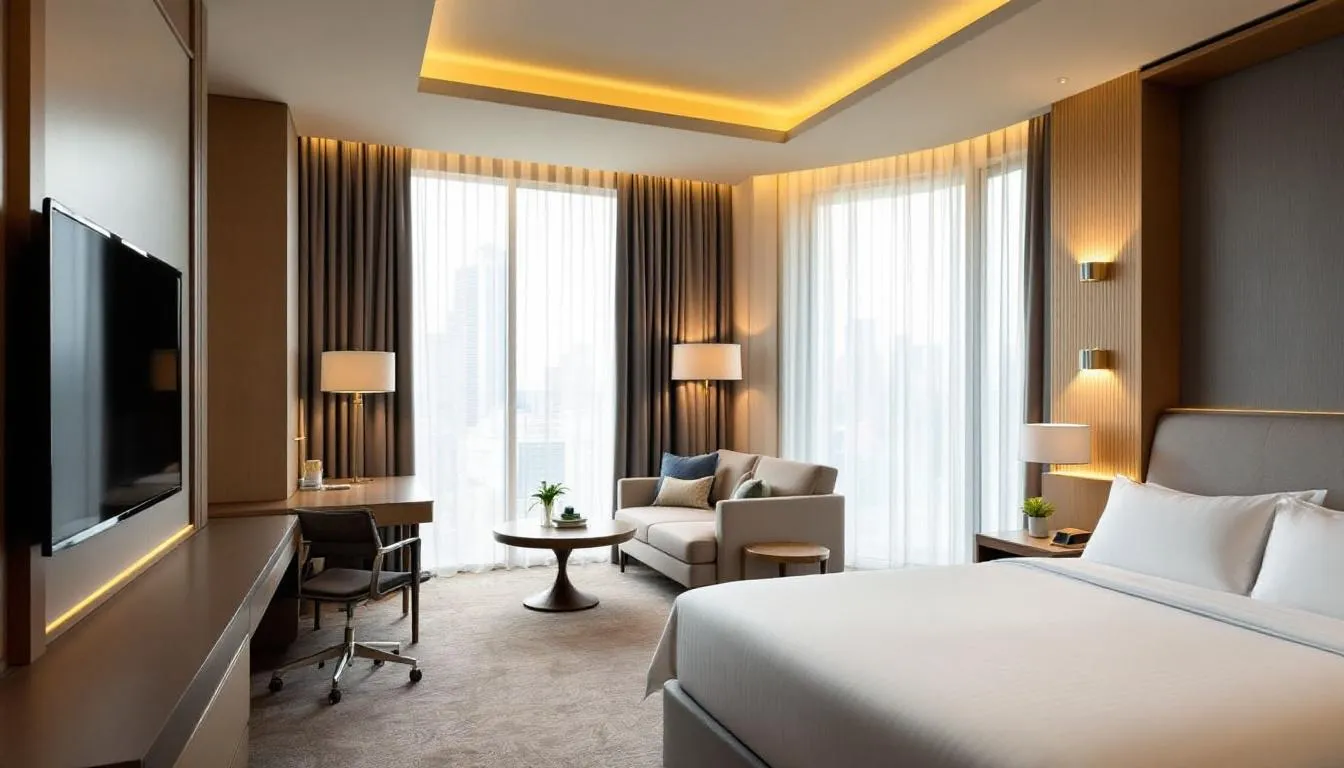Hotel Website Design: Guide to High‑Converting Sites
 Mika Takahashi
Mika Takahashi Mika Takahashi
Mika TakahashiDid you know that over 66% of hotel bookings in Asia now come from mobile devices? And this trend is quickly spreading worldwide. For hotels, this shift is both a golden opportunity and a real challenge. A well-designed website can boost your direct bookings and help you avoid those hefty OTA commissions. On the flip side, a poorly designed site might just send your potential guests straight to your competitors.
Hotel website design isn’t just about making a site look pretty. It’s a unique craft that blends technical know-how with a deep understanding of how travelers think and feel. Unlike regular business websites, hotel sites need to inspire visitors while making it super easy for them to book a room — ideally in just a few clicks.
In this guide, we’ll walk you through the key ingredients that separate hotel websites that bring in bookings from those that leave visitors clicking away. From simple hotel reservation systems to mobile-friendly designs, you’ll learn proven tips that have helped hotels increase their conversion rates by 30-50% and rake in millions more in direct booking revenue.
Simply put, hotel website design is the art and science of building a hotel’s online presence to maximize direct bookings, boost brand image, and give travelers all the info they need. It combines user-friendly design, smart conversion strategies, and hotel-specific features so your site works hard both for your business and your guests.

At its core, hotel website design is about several key pieces working together smoothly. The booking engine is the heart — letting visitors check availability and book rooms in real time. Navigation guides guests through their journey from dreaming about a trip to locking in their reservation. Content management keeps everything organized, from room details to local attractions.
Then there’s the visual design, which shows off your hotel’s personality with the right photos, fonts, and colors. Under the hood, technical stuff like fast loading times, secure payments, and integrations with your property management system keep everything running without a hitch. All these parts need to work in harmony so travelers feel confident booking with you.
Hotel websites face some unique challenges that other business sites don’t. For starters, they have to show accurate room availability and prices that can change by date, demand, or season. The booking process needs to handle payments securely and connect with a bunch of third-party systems like channel managers and OTAs.
Plus, travelers often visit hotel sites multiple times, comparing dates and room types before deciding. They want detailed photos, amenities info, and location details to help them choose. That means your content has to inspire and inform — often in several languages to welcome international guests.
The best hotel sites make booking as easy as possible. They put booking engines front and center with clear calls-to-action. Real-time availability builds trust by showing what’s actually open. Offering multiple payment options caters to different guest preferences. And trust signals like security badges, guest reviews, and certifications reassure first-time visitors.
Speed matters too — every extra second your site takes to load can cost you about 7% in conversions. So technical performance isn’t just about user experience; it directly affects your bottom line.
Good user experience (UX) means understanding what travelers need at each step of their journey. Early on, they might want to browse beautiful photos and learn about the area. When they’re ready to book, they want a fast, clear, and simple process.
Hotel UX also taps into the emotional side of travel — helping guests picture their stay and feel excited about it. The goal is to make booking not just easy but enjoyable, so visitors choose your hotel without hesitation.
Today’s hotel websites have to talk to lots of backend systems. Your property management system shares real-time room availability and pricing. Channel managers keep your listings consistent across all platforms. Customer relationship management tools help personalize guest experiences based on preferences and history.
APIs connect your site to payment processors, review sites, and marketing tools, creating a seamless ecosystem that supports both your guests and your operations. When these integrations work well, your site runs smoothly and bookings flow in.
Building a website that converts means focusing on specific features that guide visitors toward booking while building trust and reducing friction.
Your homepage’s hero section is your chance to make a great first impression. Use stunning, high-res images that highlight your hotel’s best features — whether that’s breathtaking views, luxurious amenities, or stylish design. Your messaging should quickly communicate what makes your hotel special and speak directly to your ideal guests.
Include a booking widget or clear call-to-action right there so visitors can check availability without hunting around. Keep the message short but powerful, showing why your hotel is the perfect choice.
Your booking engine should be front and center on every page — often in the header or as a sticky element that stays visible while scrolling. Use colors and fonts that stand out but still fit your brand’s look.
The booking form itself should be simple at first — just dates, number of guests, and room type. You can gather more details later to keep things quick and painless. Make sure date pickers and labels are easy to use on all devices.
Photos are your best sales tool. Each room type should have multiple sharp images from different angles and lighting, highlighting what makes it unique. Show off amenities that guests love, like pools, spas, or dining spots.
Don’t forget location shots — exterior views, neighborhood scenes, and nearby attractions help guests imagine their trip. Optimize images for fast loading without sacrificing quality on phones or desktops.

Your navigation should match how travelers think about planning trips. Main menu items often include rooms, amenities, location, dining, and special offers. Secondary menus might cover spa services, business facilities, or event spaces.
Breadcrumbs help visitors know where they are on your site, and internal links keep them exploring related pages. Keep navigation consistent across all pages to avoid confusion.
Put your phone number, email, and address somewhere visible — usually in the header or footer on every page. Adding live chat can give guests quick help during booking.
Highlight direct booking perks like best rate guarantees, exclusive amenities, or loyalty rewards. Make these offers clear throughout the site, especially on booking and confirmation pages.
With so many bookings happening on phones, your site must look and work great on smaller screens. Prioritize key info and actions, use big, touch-friendly buttons, and simplify navigation.
Mobile booking should be just as smooth as desktop, with fast load times and easy-to-use forms. Consider collapsible sections and larger fonts to improve readability.
The booking process is where your site either wins or loses guests. A smooth, trustworthy experience can boost direct bookings, while a clunky one sends visitors elsewhere.
Aim to let guests check availability, pick rooms, and pay within just a few clicks. Show progress clearly and let users easily change their choices without starting over.
Limit form fields to the essentials at first. Use auto-fill and smart defaults to save typing. Provide clear error messages so users can fix mistakes quickly. And save progress automatically in case they get interrupted.
Being upfront about room availability and prices builds trust. Show exact rates for the dates selected, including taxes and fees. Explain any dynamic pricing so guests understand why prices change.
Use scarcity messages like “Only 2 rooms left at this rate” to encourage booking without pressure. Rate calendars help flexible travelers find the best deals. Highlight package deals and promos to increase booking value.
Accept different payment options — credit cards, digital wallets, and newer services like buy-now-pay-later. Let international guests pick their currency to avoid confusion.
Show security badges and SSL certificates clearly during checkout. Make sure the page loads fast and works flawlessly — any glitch here means lost bookings.
Make account creation optional but attractive by offering perks like faster bookings, stay history, and exclusive deals. Allow social media logins to cut down on hassle.
Integrate loyalty programs so guests can earn and redeem points easily. Show real-time updates on their rewards and benefits.
Send instant confirmation emails with all the details, check-in info, and contact links. Make sure emails look good on mobile.
Let guests manage bookings online — change rooms, request early check-in, add services, or share itineraries without calling. This reduces your staff’s workload and keeps guests happy.
Behind the scenes, your site should sync with channel managers to keep availability and pricing consistent everywhere. This avoids overbooking and keeps your reputation intact.
Use these tools to offer exclusive direct booking discounts while maintaining rate parity with OTAs. This helps maximize revenue across all channels.
The Ritz-Carlton’s website shows how luxury hotels can create booking flows that match their high-end brand. Guests can add spa treatments, dining reservations, and concierge services during booking.
Their system connects with customer service so guests can get personal help seamlessly. Special requests are confirmed upfront, boosting guest confidence and average booking value.
This approach improves guest satisfaction and repeat bookings, while reducing reliance on expensive luxury travel agencies.
Visuals are what grab guests’ attention and often tip the scales before they even consider price or location.
Great hotel photos go beyond snapshots. Use natural lighting and highlight key features without harsh shadows. Each image should invite guests to imagine their stay.
Show rooms from different angles and zoom in on luxury touches. Keep style and editing consistent to tell a cohesive brand story. Use high-res images suitable for web and print.
Consistency builds trust. Use the same fonts, colors, spacing, and image styles across your site. Place your logo where visitors expect it. Make buttons and forms behave predictably.
This creates a polished look that reassures guests you pay attention to detail.
Colors influence how guests feel about your hotel. Luxury spots often use deep blues, grays, and golds. Beach resorts lean toward ocean blues and sandy tones. Mountain lodges might use earthy greens and browns.
Pick colors that look good on all devices and lighting conditions. Make sure accent colors contrast enough for easy reading.

Choose fonts that match your hotel’s personality and are easy on the eyes. Big, clear headlines help visitors scan quickly. Use elegant serif fonts for luxury, clean sans-serif for modern hotels, or casual scripts for beach spots.
Keep body text readable on all screen sizes. Use a clear hierarchy to guide attention to important info like booking buttons and special offers.
Videos can show what photos can’t — the flow of spaces, the vibe, and the real size of rooms. Property tours and location clips help guests feel connected.
Optimize videos for fast loading and include captions or descriptions for accessibility. Be cautious with auto-play so visitors aren’t startled by sound.
Interactive tours let guests explore rooms and common areas at their own pace, boosting confidence in their choice. Make sure these load quickly and work well on all devices.
Use virtual tours alongside photos to give guests as much info as they want without overwhelming them.
With more travelers booking on phones, your site must work flawlessly on mobile or risk losing bookings.
Your site should rearrange content naturally for smaller screens. Booking tools must stay front and center. Navigation should collapse into easy menus. Avoid horizontal scrolling or tiny text.
Optimize images to load quickly without losing quality. Make sure your design looks great in both portrait and landscape modes.
Buttons and links need to be big enough for fingers — usually at least 44 pixels tall. Space out clickable items to avoid mistakes.
Design navigation for easy one-handed use. Swipe gestures can make image galleries and room selections more fun.
Mobile users expect lightning-fast sites. Compress images, reduce unnecessary code, and load important content first. Lazy load images below the fold.
Use content delivery networks to speed up loading worldwide. Test on various devices and network speeds regularly.
Make forms easy to fill with dropdowns, auto-complete, and smart defaults. Optimize date pickers for touch.
Combine steps where possible and show progress indicators. Clear error messages help users fix problems without frustration.
Mobile users often book on the go. Make sure your hotel shows up in local searches and directories like Google My Business.
Use GPS to show distance to your hotel and nearby attractions. Provide maps and directions to make arrival easy.
Marriott’s mobile-first approach shows how powerful mobile optimization can be. Their progressive web app feels like a native app but doesn’t require downloads.
They streamlined booking and sped up page loads, boosting mobile conversion rates to 70%. That translates into millions in extra direct bookings and less reliance on OTAs.
Good content attracts visitors, answers their questions, and builds trust — all crucial for turning browsers into guests.
Share up-to-date info about the neighborhood — popular spots, cultural sites, transport, and business areas. Interactive maps and travel times help guests plan.
Link to attraction websites and booking platforms to add value and earn affiliate revenue.
Go beyond basics. Describe views, bed setups, tech features, and unique touches. Accurate info reduces surprises and boosts satisfaction.
List all amenities clearly — spa, gym, dining, business services, and activities. Include pricing for extras to help guests budget and increase revenue.
Social proof is huge — over 90% of travelers check reviews before booking. Show recent reviews from multiple platforms and respond to negative feedback professionally.
Use testimonials from different guest types — business travelers, families, couples. Video testimonials add authenticity.
Regular blog posts improve hotel search rankings and keep visitors coming back. Topics can include local events, travel tips, hotel news, and seasonal activities.
Show your hotel’s personality with behind-the-scenes stories and staff spotlights. Make sure content is useful and optimized for search engines.

International travelers prefer browsing and booking in their own language. Use professional translations that consider cultural nuances.
Tailor content for different markets — business travelers might want different info than leisure guests. Show local contact details and currency for each audience.
Create urgency with seasonal packages combining rooms with dining, spa, or attraction tickets. Highlight savings and exclusive perks.
Be clear about terms and availability. Use booking deadlines and calendars to encourage timely reservations. Share success stories and testimonials to boost conversions.
Your website’s technical health affects user experience, security, and search rankings — all impacting bookings and revenue.
Compress images using formats like WebP. Use lazy loading to delay off-screen images. Minify CSS and JavaScript to reduce file sizes.
Use content delivery networks to serve content fast worldwide. Optimize your database for quick queries on availability and pricing.
SSL certificates are a must — browsers warn users about insecure sites, which kills trust. Make sure all parts of your site are covered.
Follow PCI DSS standards for payment security. Use encrypted transmissions and tokenization so credit card data isn’t stored locally.
For hotels with international guests, CDNs ensure fast loading no matter where visitors are. They also help protect against traffic spikes and attacks.
Your database should handle many users checking availability simultaneously without slowing down. Use indexing and query optimization to keep things snappy.
Have backups and redundancy to avoid data loss or overbooking. Test your recovery plans regularly.
Reliable API connections keep your website synced with property management, channel managers, and payment processors. They handle room availability, pricing, and guest info updates in real time.
Make sure your system handles errors gracefully to avoid broken bookings.
Regular backups stored in different locations protect your data. Test your recovery procedures to ensure quick restoration during outages.
Have contingency plans like temporary booking systems or alternative contacts to keep operations running smoothly.
Monitor your site’s uptime, speed, and errors constantly. Use alerts to fix issues before they affect guests.
Investing in a strong technical foundation pays off with happier guests, higher conversions, and fewer headaches.
In today’s competitive hotel market, a well-designed website isn’t just nice to have — it’s essential. Hotels that invest in professional, conversion-focused websites consistently outperform those that rely heavily on OTAs, saving thousands in commissions and building stronger guest relationships.
The strategies we’ve covered — from easy booking flows to mobile optimization and solid technical infrastructure — work together to turn visitors into guests. Properties using these best practices have seen conversion rates jump by 30-50% and direct booking revenue soar.
Remember, hotel website design is an ongoing journey, not a one-and-done project. Keep updating, testing, and improving to stay ahead in the ever-evolving digital landscape. The sooner you start, the more bookings and revenue you’ll gain. Don’t wait — your next guest is just a click away.